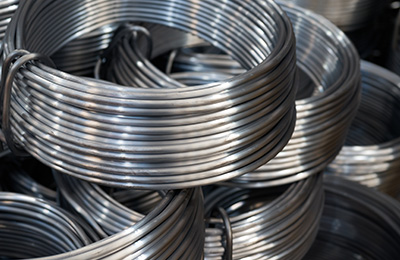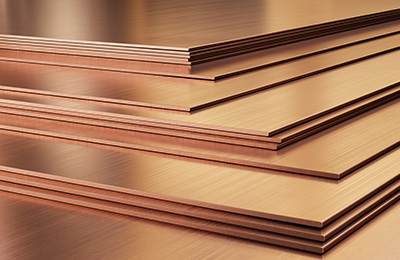About Us
Materials
Aluminum Alloys
| Alloy | Temper | Ductility | Strength | Corrosion Resistance | Heat Treatable | Comments |
|---|---|---|---|---|---|---|
| 6061 | T6 | Low | Mid | Good | No | Minimum bend radii of 3x raw material thickness. |
| 6061 | T0 | High | Low | Good | Yes | Higher-cost heat treating due to warping and need for secondary straightening. |
| 5052 | H32 | High | Mid | Good | No | Most commonly used aluminum alloy and temper. |
| 5052 | H34 | Mid | High | Good | No | Small radii bends in line with grain may fracture. |
| 3003 | H14 | High | Low | Good | No | Good for deep drawn parts. |
Stainless Steel
| Alloy | Temper | Ductility | Strength | Corrosion Resistance | Heat Treatable | Comments |
|---|---|---|---|---|---|---|
| 301 302 304 |
*Range | **High | High | Excellent | No | Small radii bends in line with grain may fracture in full hard temper. Full hard temper is cost effective for springs as there is no need for heat treating or plating. |
| 316 316L |
Annealed | High | High | Excellent | No | Used heavily in the medical industry. |
| 410 | Annealed | High | Mid | Mid | Yes | Excellent for springs. Stays stable in heat treating and has a bright finish. |
| 17-4 PH | Annealed | Low | Excellent | Mid | Yes | Small radii bends in line with grain may fracture. |
| 17-7 PH Cond. A |
Annealed | Mid | High | Mid | Yes | Excellent for springs intended for repeated cycles. Remains stable during heat treating. |
| 17-7 PH Cond. C |
Mill Hardened | Low | High | Mid | Yes | Small radii bends in line with grain may fracture. Highest hardness and strength achievable in alloy 17-7 PH. |
*Annealed, 1/2, 1/4, 3/4, and full hard possible
** Ductility decreases in harder tempers and mill hardened materials
** Ductility decreases in harder tempers and mill hardened materials
Low Carbon and Spring Steel
| Alloy | Temper | Ductility | Strength | Corrosion Resistance | Heat Treatable | Comments |
|---|---|---|---|---|---|---|
| 1008 1010 |
Soft, 1/2, 1/4 Full Hard | High | Mid | *Poor | **Yes | When rolled at or near room temperature, excellent ductility and strength is produced and is more uniform than hot rolled steel. |
| 1008 1010 |
Annealed | High | Mid | *Poor | **Yes | Rolled at a temperature greater than the recrystallization point, which produces surface scale. Good ductility, but weaker and less uniform than cold rolled steel. |
| HSLA | Annealed | Mid | High | *Poor | **Yes | Requires 25-30% more power to form than cold rolled steel or hot rolled steel. |
| 1050 1074 1075 1095 |
Annealed | Excellent | ***High | *Poor | Yes | 1095 has the highest carbon content of the materials listed. Higher carbon content yields higher strength with less ductility after heat treating. |
| 1095 | Blue Tempered | Low | High | Mid | No | Good for flat springs or leaf springs with large radii. |
*Poor without plating or surface treatment
** Limited to carburizing
*** High strength after heat treatment
** Limited to carburizing
*** High strength after heat treatment
Copper Alloys
| Alloy | Temper | Ductility | Strength | Corrosion Resistance | Heat Treatable | Comments |
|---|---|---|---|---|---|---|
| C110 Copper | Wide Range | High | Mid | Good | No | Highly conductive. High cost. |
| C172 Beryllium Copper | Wide Range | Excellent | Excellent | Fair | Yes | Excellent for electrical spring contacts. Highly conductive, excellent electroplating adhesion coefficient and remains very stable during heat treating. Moderate cost. |
| C260 Brass | Wide Range | *Ranges | High | Good | No | Small radii bends in line with grain may fracture in full hard and spring tempers. |
| C510 Phosphor Bronze | Wide Range | *Ranges | High | Fair | No | Small radii bends in line with grain may fracture in full hard and spring tempers. |
*Ranges according to temper




Raw Materials Selection
Heat Treatable Alloys
When stiffness and spring characteristics are required, the design engineer should consider the following: For parts with small radius forms, high carbon spring steel or another heat treatable metal with good ductility may need to be used. The part may require heat-treating after forming to achieve necessary stiffness or spring performance characteristics, which adds to manufacturing cost. Note that broad flat sections in high carbon spring steel parts tend to warp during heat treating. Where potential warping may be a factor, it is wise to consider alternate materials that may have a marginally higher cost but stay more stable during heat treating.
- 410 Stainless Steel
- 17-7 PH Stainless Steel, condition A (annealed)
- C172 Beryllium copper
- Low Carbon Cold Rolled Steel – carburizing hardens the surface while reducing spring characteristics
Mill Hardened Alloys
For flat parts or parts with large radius form features, a mill-hardened alloy may be selected based on hardness or spring performance characteristics to eliminate the need for heat treating.
Consider the following:
Consider the following:
- 6061 Aluminum in T4 or T6 temper
- 300 series Stainless Steel in 1/4, 1/2, 3/4 or full hard temper
- 1095 blue temper spring steel
- C110 Copper and C260 Brass in H04 (hard), H06 (extra hard), H08 (spring temper) and H10 (extra spring temper)
- C510 Phosphor Bronze in H06 (extra hard), H08 (spring temper) and H10 (extra spring temper) Note that raw material grain impacts forming characteristics in all materials, but more so in mill-hardened alloys.

